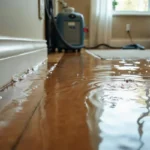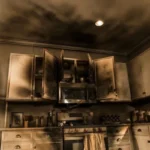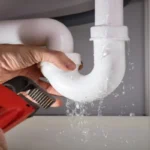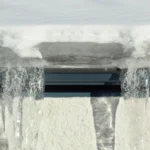Mold mites may be an unfamiliar term for many, often overshadowed by the more well-known issue of mold itself. These microscopic creatures thrive in damp environments where mold is present, rapidly multiplying in humid conditions. While mold mites do not pose a direct health threat, their presence indicates an underlying moisture and mold problem that can affect indoor air quality and lead to allergic reactions.
What Are Mold Mites and How Do They Develop?
Mold mites, scientifically known as Tyrophagus putrescentiae, are microscopic arachnids that primarily feed on mold. These tiny, hairy insects are found worldwide and flourish in environments with high moisture levels, making them common in homes with persistent humidity issues. Unlike dust mites, which thrive in bedding and upholstery, mold mites congregate in damp areas, feeding on the mold that forms on walls, ceilings, stored food, and other organic surfaces.
Mold mites develop when conditions allow for excessive mold growth. Poor ventilation, water leaks, and high humidity levels create the perfect breeding ground. Since they are so small, mold mites often go unnoticed until they multiply into large colonies, signaling an extensive mold problem.
Signs That You Have Mold Mites in Your Home
Identifying mold mites requires keen observation, as they are almost invisible to the naked eye. Here are the most common signs that mold mites are present in your home:
1. Visible Mites
Mold mites are incredibly small, often appearing as translucent or white specks on moldy surfaces. Due to their minuscule size—typically less than 0.5 millimeters—they can easily be mistaken for dust or lint. However, you may notice them moving in clusters when viewed under a magnifying glass or close inspection.
They often congregate on damp surfaces, around moldy food, or in humid areas like basements and bathrooms. If you suspect an infestation, running a wet cloth over moldy areas may reveal tiny moving specks, confirming the presence of mold mites.
2. Mold Growth
Mold mites rely entirely on mold for sustenance, meaning their presence is almost always tied to mold outbreaks in the home. If you notice mold forming on walls, ceilings, wood, or even stored food, mold mites are likely nearby, feeding on the fungal growth. Mold can develop from high humidity, leaks, condensation, or poor ventilation.
Checking hidden areas, such as behind furniture, under sinks, or in storage areas, can help detect mold early. If mold growth is visible, mold mites will often appear soon after, further worsening the contamination.
3. Musty Odor
A strong, musty smell is often a reliable indicator of mold growth and, subsequently, mold mites. This odor results from microbial volatile organic compounds (MVOCs) released by mold as it grows. The smell is particularly strong in damp or poorly ventilated areas, such as basements, bathrooms, and attics. If you notice a persistent earthy or musty scent, mold mites may still be present even in the absence of visible mold.
The scent can become more pronounced after rain, increased humidity, or poor air circulation. Since mold mites thrive in these conditions, tracking the source of the musty odor can help locate an infestation. Properly ventilating the space and using dehumidifiers can reduce the chances of mold and mites spreading.
4. Allergic Reactions
Mold mites can trigger a range of allergic reactions in individuals sensitive to allergens. Their microscopic hairs and body fragments can become airborne, leading to sneezing, congestion, itchy eyes, and respiratory discomfort. Those with asthma or pre-existing allergies may experience worsened symptoms, particularly in rooms with high mold concentrations.
Skin irritation, redness, and rashes may also occur if mold mites or waste particles come into direct contact with the skin. Symptoms tend to be more pronounced in areas where mold is present, such as basements, kitchens, or bathrooms. If allergy symptoms persist indoors and subside when leaving the house, mold mites or mold spores could be the underlying cause.
5. High Humidity and Moisture Issues
Excess humidity and moisture create the perfect breeding ground for mold mites. Homes with persistent condensation, water leaks, or poor ventilation are more prone to mold growth and attract mites. Bathrooms, laundry rooms, basements, and kitchens are common problem areas due to frequent exposure to moisture. If surfaces remain damp for extended periods, mold and mites will quickly thrive.
Checking for signs of moisture damage—such as peeling paint, water stains, or mildew—can help detect problem areas early. Keeping humidity levels below 50%, fixing leaks, and improving air circulation can significantly reduce mold mite infestations. A dry home environment makes it harder for mold and mites to survive, preventing future outbreaks.
Health Risks Associated with Mold Mites
While mold mites do not bite or transmit diseases, their presence can still pose indirect health risks, particularly for those with allergies or respiratory conditions. Their microscopic hairs can become airborne, triggering symptoms similar to dust mite allergies. Exposure to mold mites may lead to:
- Respiratory Issues – Sneezing, congestion, and difficulty breathing due to airborne allergens.
- Skin Irritation – Direct contact may cause itching or rashes in sensitive individuals.
- Worsening Asthma – Mold mite allergens can exacerbate asthma symptoms in those prone to respiratory issues.
Furthermore, mold mites indicate significant mold growth, which can cause more severe health problems, including toxic mold exposure.
How to Get Rid of Mold Mites Effectively
To eliminate mold mites, you must first remove their primary food source. Here are the best steps to get rid of mold mites and prevent their return:
1. Identify and Eliminate Mold Growth
Find the areas in your home where mold is growing and clean them immediately. Use a mold removal solution such as:
- A mixture of white vinegar and water
- Hydrogen peroxide (3%)
- A commercial mold-killing cleaner
Scrub affected areas thoroughly and ensure they dry completely to prevent regrowth.
2. Control Humidity Levels
Mold mites thrive in humid conditions. Keep indoor humidity levels below 50% by:
- Using a dehumidifier in damp areas like basements and bathrooms
- Running exhaust fans when cooking or showering
- Ensuring proper ventilation in all rooms
3. Clean and Vacuum Regularly
Use a HEPA filter vacuum cleaner to remove mold spores and mites from surfaces. To prevent mold buildup, wipe down furniture, floors, and walls with antimicrobial cleaning agents.
4. Repair Water Leaks
Check for leaks in plumbing, windows, and roofs. Fixing these issues will eliminate excess moisture that fosters mold and mite infestations.
5. Use Desiccants or Moisture Absorbers
Placing silica gel packs or activated charcoal in high-humidity areas can help absorb excess moisture and prevent mold growth.
Preventing Future Mold Mite Infestations
Taking proactive steps can help you keep mold mites from returning. Here are some effective prevention strategies:
- Improve Air Circulation – Open windows and doors when possible to promote airflow and prevent moisture buildup.
- Keep Surfaces Dry – Regularly wipe down countertops, sinks, and bathroom surfaces to prevent mold formation.
- Use Mold-Resistant Materials – Choose mold-resistant paint, drywall, and flooring when renovating.
- Store Food Properly – Ensure stored food remains dry and mold-free, as mold mites can also infest food sources.
- Schedule Regular Home Inspections – Periodically inspect your home for signs of moisture, leaks, or mold problems before they escalate.
When to Seek Professional Mold Removal Services
While minor mold and mite infestations can often be handled with DIY cleaning methods, severe cases require professional intervention. You should consider hiring a mold remediation specialist if:
- Mold covers an area larger than 10 square feet.
- You notice persistent mold growth despite cleaning efforts.
- The infestation is causing significant allergic reactions or respiratory issues.
- Mold has spread to porous materials like drywall, insulation, or carpets.
- Extensive water damage contributes to mold development.
SS Water Restoration offers professional mold removal services to help homeowners safely eliminate mold and prevent future infestations. Their trained technicians use advanced mold detection, removal, and prevention techniques to restore indoor air quality and safeguard your home against mold mites.
Conclusion
Mold mites are small but persistent pests that grow in humid environments with mold. While they are not directly harmful, their presence is a warning sign of an underlying moisture problem that can impact air quality and health. You can effectively prevent and remove mold mites by eliminating mold, controlling humidity, and maintaining a clean home. However, in cases of severe mold infestations, professional remediation services may be necessary to ensure a thorough and lasting solution. Taking proactive steps to reduce moisture and mold will help keep your home safe, clean, and mite-free.












